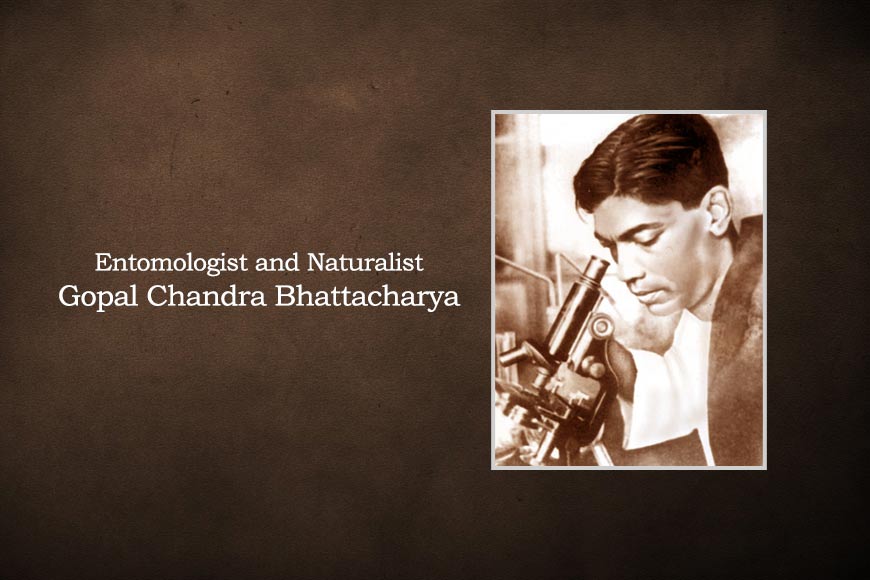Tracing the life and times of Bengal’s pioneer entomologist who created a science legacy - GetBengal story

Gopal Chandra Bhattacharya, an Indian entomologist and naturalist
Actor Steve Martin had once said, “The public has a short memory…” and he was not too far from the truth. How conveniently we have forgotten the pioneering entomologist and naturalist, Gopal Chandra Bhattacharya. This year marks his 125th birth anniversary. Born on August 1, 1895, in Lonesing, Fardipur district (now in Bangladesh), Bhattacharya was a very bright student who passed his Matriculation examination with a first class but owing to acute financial crisis, he had to give up his dream of pursuing higher education and join his deceased father’s profession as a village priest. However, he was born with a scientist’s mindset and nothing could deter his insatiable pursuit of knowledge. In 1932, he published his first research papers on life events in the body of plants. Subsequently, he also published work on bioluminescence and other botany topics.
There is an interesting story related to the bioluminescence discovery. In those days, it was a common to spot sudden spark of light in wet, deserted places. ‘Aleyar alo,’ as the mysterious light is called, was believed to be ominous that attracted the onlooker to his death. Bhattacharya decided to probe the source and find out the actual reason. To unravel the mystery, he headed for 'Panchir Maa-r Bhita' on a rainy night. The ‘bhita’ (house) had been long abandoned and the crumpling residence stood on a deserted plot, far from the village with wild vegetation taking over the ruined structure. It was believed to be haunted and no villager ever ventured to be anywhere close to it.
However, nothing could stop Bhattacharya’s resolution to visit the spot. As he walked, he spotted a faint ray of light emanating in the pitch dark from the southwest corner. As he got closer, the light seemed to increase and radiate and then suddenly it went off only to appear from nowhere again. A valiant and curious Bhattacharya kept moving towards the source of the light and noticed a huge furnace. No flames emerged from the fireplace. Instead, the blaze resembled bright charcoal fire but lacked the intense heat. He observed that this light could be seen only during nighttime when it rained in the forest during dry summer days but remained invisible during the day. He researched on this natural phenomenon and discovered that dry and decaying plants and leaves in the jungles can produce and emit light through chemical reactions in the cells. It is called Bioluminescence or the ability of living organisms to produce light in their body. This was his first scientific research work on the power of decaying plants to emit light and his article was published in ‘Probasi,’ the famous Bengali journal of the time in 1919.
Polymath Sir Jagadish Chandra Bose had set up Bose Institute (Basu Vijnyan Mandir), a premier research institute in 1917, the first interdisciplinary research centre in Asia. He was impressed by Gopal Chandra’s article in ‘Probasi,’ and invited him to join Bose Institute and carry out his research. Bhattacharya joined the organization in 1921 and remained an integral part of it until 1971.
Bhattacharya was a keen observer of indigenous plants, insects and animals of Bengal and studied their life cycles. He was a naturalist and his observation entailed a qualitative research method where he recorded the behaviors of his research subjects in real world settings and avoided interfering with or influencing any variables in his naturalistic observation. He conducted extensive field research on frogs, ants, bees and spiders and noted down his observations elaborately. In 1930, his detailed observation on fishing spiders was published in Bose Institute’s Transaction (journal).
Bhattacharya worked extensively on ant-mimicking jumping spiders aka Myrmarachne spiders and the lizard-eating spiders of Bengal and in 1934-35, four of his research papers were published in the prestigious science journals including the Natural History Society, Bombay, American Scientific Monthly and Science and Culture, Calcutta. Sir Bose was hopeful that Bhattacharya’s outstanding research would bestow him international exposure and establish him as an entomologist in the global academic world. However, the situation in Europe was volatile at that time due to economic crisis and political extremism was raising its ugly head. Hitler's rise to power and the beginning of World War II dashed all his hopes.
Bhattacharya created his testing ground with ordinary, often insignificant ingredients and discovered outstanding gems. In order to study the reproductive cycle of ants, Bhattacharya planted a mango tree in a large pot and made an ant nest in the tree. However, he let only worker ants live in the nest and made a moat around the tree to bar the entry of other ants in the nest. After six weeks, he found ant eggs and larvae in the nest and there was a considerable rise in the number of ants as well. How was this possible without the presence of the queen ant? Between 1939 and 1941, he carried out his experiment by changing the behavioural pattern of ants, their food and nesting habits to understand their process of procreation.
During Bhattacharya’s long stint at Bose Institute, many of his important research articles were published regularly in renowned scientific journals in the country and abroad. He was the quintessential naturalists whose eyes were literally glued to the ground looking at worms, insects and arthropods crawling on ground or walking on water and every time he spotted anything new or an anomaly, he reacted instantly and wasted no time to initiate his field study. Through years of observation and meticulous field notes, Bhattacharya discovered unique features in the natural world, which are still a wonder of the scientific world.
Bhattacharya was not only a scientist but a teacher as well who was enthusiastic to spread the scientific temperament among the masses. He used to impart education to the poor, so-called ‘untouchable’ lowborn people of the society. He penned folk songs and mythological stories interspersed with insightful information on different aspects of science to sensitize the uneducated villagers and gently nudge them to shed their superstitions and think and act logically.
To spread the knowledge of science in one’s Mother tongue, renowned scientist and Professor Dr. Satyendra Nath Bose founded the Bangiya Bijnan Parishad on 25 January 1948 that led the science-movement in Bengal. On the day of the inauguration of the Parishad, a monthly journal of science in Bengali language, named Jnan-O-Bijnan was also launched. Bhattacharya was closely associated with Dr. Bose in his venture and Dr. Bose entrusted him with the editorship of ‘Jnan-O-Bijnan’ magazine. During his nearly three decades as editor, Bhattacharya unveiled a new and glorious chapter in science literature.
Although he had no formal college degree, Bhattacharya is regarded as one of the foremost entomologists of the country. The University of Calcutta awarded him honorary Doctor of Science degree months before he died. He was awarded the Ananda Puraskar for Bengali literature in 1968, and in 1975, received Rabindra Puraskar, the highest award for Bengali literature. He was an expert photographer, and clicked myriad varieties of ants, spiders, small bats and tadpoles. In total, he published 22 papers in English, including in journals such as the Natural History of the American Museum of Natural History. He breathed his last on April 8, 1981, leaving behind a legacy of a brilliant scientific mind. His groundbreaking approach to research and discovery continues to serve the world at large.










